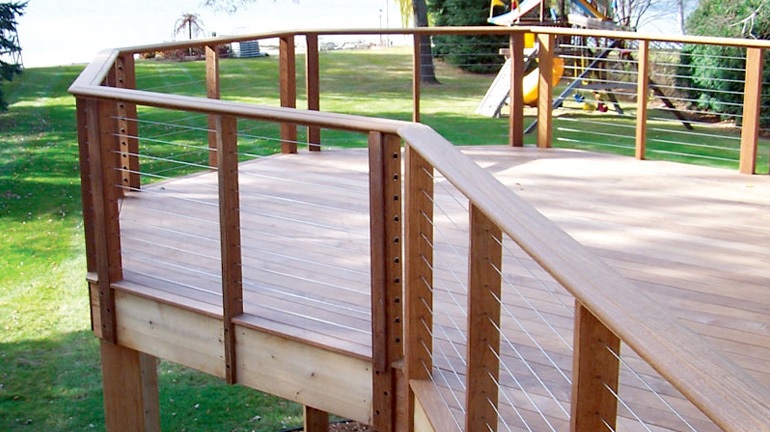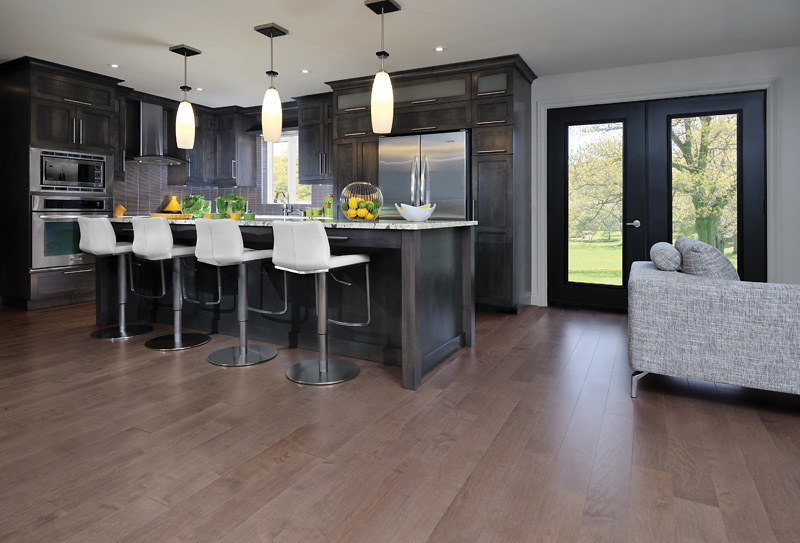The Perfect Guide to Choosing Cable Deck Railing Systems for Your Home

Key Takeaways:
- Cable deck railing systems offer a sleek and minimalist design, providing unobstructed views of the surroundings and a sense of security.
- Cable deck railing systems are low maintenance, durable, and versatile in design.
- Choosing the right material, height, and spacing is crucial for safety and compliance.
- Consider budget-friendly options such as aluminum cable railings or pre-assembled kits.
- Installation requires following manufacturer instructions and obtaining necessary permits.
- Maintain cable deck railing systems with regular cleaning and inspections.
- Enhance the style of your deck with different colors, finishes, and customization options.
- Incorporate lighting features into the cable deck railing system for enhanced aesthetics and safety.
1. Understanding the Benefits of Cable Deck Railing Systems
When it comes to deck railing systems, cable deck railing systems have become the go-to choice for modern homes. The sleek and minimalist design of these systems can elevate the aesthetics of any deck while providing numerous benefits.
Why Cable Deck Railing Systems Are the Go-To Choice for Modern Homes
Cable deck railing systems have gained popularity among homeowners and designers for their contemporary and stylish appeal. Unlike traditional railing systems, cable deck railings offer unobstructed views of the surroundings, allowing you to fully enjoy the beauty of your outdoor space. Whether you have a breathtaking backyard landscape or an expansive sea view, cable deck railings can help you make the most of it.
Besides their aesthetic appeal, cable deck railing systems also provide a sense of security without compromising the view. The combination of sturdy cables and durable posts ensures the safety of your deck while maintaining an open and spacious feel.
The Advantages of Using Cable Deck Railing Systems
Cable deck railing systems offer several advantages over traditional railing options. One of the key advantages is their low maintenance requirements. Unlike wooden or metal railings that may require frequent painting or staining, cable deck railings are typically made of stainless steel or aluminum, which are highly resistant to rust and corrosion. This means you can spend less time on maintenance and more time enjoying your deck.
Another advantage of cable deck railing systems is their durability. The high-quality materials used in these systems ensure long-lasting performance, even in harsh weather conditions. This makes them an excellent investment for homeowners looking for a railing solution that can withstand the test of time.
In addition to their durability, cable deck railing systems are also known for their versatility. They can be installed in various configurations, including horizontal and vertical designs, allowing for customization based on your specific requirements and design preferences.
Elevate Your Deck’s Aesthetics with Cable Deck Railing Systems
One of the standout features of cable deck railing systems is their ability to enhance the overall aesthetics of your deck. The sleek and modern design of these systems adds a touch of sophistication to any outdoor space.
Furthermore, cable deck railing systems can be combined with different materials, such as wood or composite decking, to create a visually stunning and cohesive look. The contrast between the warmth of the wood and the sleekness of the cables creates a visually appealing focal point that will impress your guests.
Moreover, cable deck railing systems offer the flexibility to choose from a variety of finishes and colors. Whether you prefer a classic stainless steel look or want to add a pop of color with a powder-coated finish, there are endless options to match your personal style and complement your deck’s design.
2. Factors to Consider When Choosing Cable Deck Railing Systems
Before installing a cable deck railing system, there are several important factors to consider. From the material of the cables to the ideal height and spacing, these considerations will help you make an informed decision and ensure the safety and functionality of your railing system.
Material Matters: Exploring the Different Options for Cable Deck Railing Systems
When it comes to cable deck railing systems, stainless steel and aluminum are the most commonly used materials. Both options offer excellent durability and strength.
Stainless steel cable railing systems are highly resistant to corrosion, making them ideal for outdoor applications. They are available in various grades, with 316-grade stainless steel being the most recommended for its superior resistance to rust and corrosion. Stainless steel cables can also be paired with different types of posts, such as wood, aluminum, or steel, depending on the desired aesthetic and structural requirements.
On the other hand, aluminum cable railing systems are lightweight and easy to work with. They are powder-coated for enhanced durability and can be customized in a wide range of colors to match your deck’s style. Aluminum cables are also corrosion-resistant, making them a suitable choice for coastal areas where saltwater exposure is a concern.
Determining the Ideal Height and Spacing for Cable Deck Railing Systems
The height and spacing of your cable deck railing system are crucial for safety and compliance. The International Residential Code (IRC) sets the minimum height requirement for residential decks at 36 inches. However, local building codes may have specific requirements, so it’s important to check with your local authorities.
When it comes to cable spacing, the IRC specifies that cables should not allow the passage of a 4-inch sphere. This guideline ensures that children and pets cannot squeeze through the gaps. While most cable deck railing systems adhere to this standard, it’s essential to verify the spacing requirements with your chosen manufacturer or supplier.
Budget-friendly Options: Finding Affordable Cable Deck Railing Systems
Cable deck railing systems can vary in price depending on factors such as materials, finishes, and customization options. However, there are budget-friendly options available that provide an excellent balance between cost and quality.
If you’re on a tight budget, opting for aluminum cable railing systems may be a more affordable choice compared to stainless steel. Aluminum offers durability and versatility at a lower cost, making it a popular option for cost-conscious homeowners.
Additionally, some manufacturers offer pre-assembled cable railing kits that can help reduce installation costs. These kits typically include all the necessary components and instructions, making them a convenient and budget-friendly option for DIY enthusiasts.
3. Installation and Maintenance Tips for Cable Deck Railing Systems
Installing and maintaining a cable deck railing system requires proper techniques and care. By following these tips, you can ensure a successful installation and keep your railing system in optimal condition for years to come.
A Step-by-Step Guide to Installing Cable Deck Railing Systems
Before you begin the installation process, it’s important to carefully read the manufacturer’s instructions and obtain any necessary building permits. Here’s a general step-by-step guide for installing a cable deck railing system:
- Determine the layout and spacing of your cables according to local building codes and manufacturer guidelines.
- Install the necessary posts or supports for your railing system. Ensure they are securely fastened to the deck surface.
- Thread the cables through the designated holes in the posts or supports. Use a cable cutter to trim the cables to the desired length.
- Attach the end fittings to the cables and fasten them to the posts or supports using appropriate hardware.
- Tighten the cables, ensuring they are taut and properly tensioned. This can be done using a cable tensioning tool or a turnbuckle.
- Double-check the alignment and tension of each cable, making any necessary adjustments.
- Finally, inspect the entire railing system to ensure it is structurally sound and meets all safety requirements.
Keeping it Clean: Easy Maintenance Tips for Cable Deck Railing Systems
Maintaining a cable deck railing system is relatively simple and requires minimal effort. However, regular cleaning and inspection are necessary to keep the system in optimal condition.
To clean your cable deck railing system, use a mild detergent mixed with water and a soft brush or sponge. Gently scrub the cables and posts to remove any dirt, grime, or residue. Avoid using abrasive cleaners or tools that may scratch or damage the surface.
After cleaning, rinse the railing system thoroughly with water to remove any soap residue. Regularly inspect the cables and fittings for signs of wear, corrosion, or loose connections. If any issues are detected, address them promptly to prevent further damage.
Ensuring Safety and Compliance with Cable Deck Railing Systems
When installing a cable deck railing system, it’s crucial to ensure compliance with local building codes and safety standards. Following the guidelines set by the IRC and obtaining any necessary permits will help ensure the safety of your railing system.
Regular inspections of your cable deck railing system are also important for maintaining safety. Check for any loose cables, damaged fittings, or signs of wear, and promptly address any issues that may compromise the structural integrity of the railing system.
4. Enhancing Your Deck’s Style with Cable Deck Railing Systems
Choosing the right cable deck railing system goes beyond functionality. By considering factors such as color, finish, and customization options, you can enhance the style and visual appeal of your deck.
Choosing the Right Color and Finish for Cable Deck Railing Systems
Cable deck railing systems offer a range of options when it comes to color and finish. You can choose a classic stainless steel look that complements various deck styles or opt for a powder-coated finish for a more customized appearance.
When choosing a color for your cable deck railing system, consider the overall aesthetic of your deck. If you have a traditional or rustic-style deck, a stainless steel or black finish can provide a timeless appeal. For a more contemporary or vibrant deck, colors such as white, bronze, or custom shades can offer a personalized touch.
Adding Personalized Touches: Customization Options for Cable Deck Railing Systems
Customization options for cable deck railing systems allow you to add unique touches that reflect your personal style and preferences. From choosing different post styles to incorporating decorative elements, here are some customization options to consider:
– Post Styles: Explore various post styles, such as sleek metal posts, traditional wooden posts, or a combination of both, to create a custom look.
– Top Rail Options: Consider different materials and shapes for the top rail, such as wood, aluminum, or a curved design, to add an extra element of style.
– Accent Lighting: Enhance the ambiance of your deck by incorporating LED lighting into your cable railing system. This can create a warm and inviting atmosphere, especially during nighttime gatherings.
– Decorative Panels: If you want to add privacy or a unique design element, consider incorporating decorative panels between the cable infill. These panels can be made from various materials, such as glass, metal, or composite.
Incorporating Lighting Features into Cable Deck Railing Systems
Lighting can play a significant role in enhancing the overall look and functionality of your deck. By incorporating lighting features into your cable deck railing system, you can create a stunning visual effect and increase safety during nighttime use.
LED strip lights can be installed along the underside of the top rail or within the post to provide a soft and subtle glow. This type of lighting is energy-efficient, long-lasting, and can be controlled with a dimmer switch to create the desired ambiance.
Additionally, recessed or spotlights can be strategically placed near the posts or around the deck area to highlight architectural features, landscaping, or seating areas.
Remember to consult a professional electrician to ensure proper installation and adherence to electrical codes.
Choosing the right cable deck railing system for your home involves considering several factors such as materials, design options, installation, and maintenance. By understanding the benefits and opportunities for customization, you can create a deck railing system that not only provides safety and functionality but also enhances the overall aesthetics of your outdoor space. With proper care and attention, your cable deck railing system will continue to impress and delight you for years to come.
FAQ
Question: Are cable deck railing systems easy to maintain? – Cable deck railing systems are low maintenance, as they are typically made of stainless steel or aluminum, which are highly resistant to rust and corrosion. Regular cleaning and inspections are recommended to keep the system in optimal condition.
Question: What are the advantages of using cable deck railing systems? – Cable deck railing systems offer a sleek and minimalist design, providing unobstructed views of the surroundings while maintaining a sense of security. They are low maintenance, durable, and versatile in design.
Question: How do cable deck railing systems enhance the style of a deck? – Cable deck railing systems have a sleek and modern design that adds a touch of sophistication to any outdoor space. They can be combined with different materials and finishes, allowing for customization and creating a visually stunning look.
Question: What materials are commonly used in cable deck railing systems? – Stainless steel and aluminum are the most commonly used materials for cable deck railing systems. Stainless steel is highly resistant to corrosion, while aluminum is lightweight and easy to work with. Both materials offer durability and strength.
Question: How do I determine the ideal height and spacing for my cable deck railing system? – The International Residential Code (IRC) sets the minimum height requirement for residential decks at 36 inches. The spacing between the cables should not allow the passage of a 4-inch sphere to prevent children and pets from squeezing through. It is important to check the specific requirements of your local building codes.
Question: Are there budget-friendly options for cable deck railing systems? – Yes, there are budget-friendly options available for cable deck railing systems. Aluminum cable railing systems are typically more affordable than stainless steel, while pre-assembled cable railing kits can help reduce installation costs.
Question: How do I install a cable deck railing system? – It is important to carefully read the manufacturer’s instructions and obtain any necessary building permits before installing a cable deck railing system. The general steps include determining the layout and spacing, installing the necessary posts or supports, threading the cables, attaching the end fittings, tightening the cables, and double-checking the alignment and tension.
Question: How do I maintain and clean a cable deck railing system? – To clean a cable deck railing system, use a mild detergent mixed with water and a soft brush or sponge. Gently scrub the cables and posts to remove dirt and grime, and rinse thoroughly with water. Regular inspections should be conducted to check for wear, corrosion, or loose connections.











